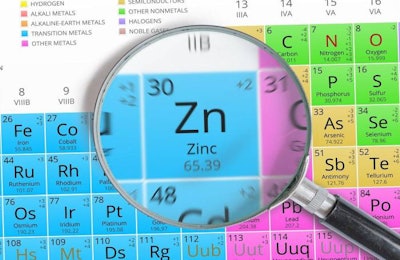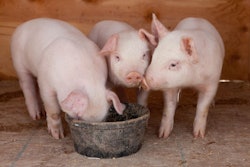
Latest research from the United Kingdom suggests that a novel way of producing nano-minerals brings benefits for broiler chickens in terms of improved performance and bone strength.
Supplying minerals as tiny particles (nano form) might be expected to increase bioavailability to the animal. As a result, this could lead to positive effects on production, health and welfare.
Using a novel method of producing nano-minerals, scientists at Nottingham Trent University (NTU) have been able to demonstrate these benefits in practical feeding trials.
Compared with birds fed standard inorganic zinc, broilers fed the nano-zinc had higher feed intake and grew faster. Some positive impacts were also observed on the strength of the tibia (upper leg bone).
Zinc: Essential mineral …
It is known that broilers whose diets are deficient in zinc grow more slowly, and they have shorter and thicker legs with enlarged hocks. Frizzled feathers are a further signs of shortage of this mineral.
To avoid these adverse signs and to ensure healthy growth, broiler diets need to contain adequate zinc. However, NTU explains that, while many poultry feed ingredients — of both plant and animal origin — contain zinc, this mineral is often present in a form that makes it unavailable to the bird. In plant sources, for example, the zinc is bound to phytate, which reduces mineral absorption in the gastrointestinal tract.
As a result, animal feeds are routinely supplemented with zinc.
… balance is vital
Achieving the right balance is crucial, however. Supplies need to be adequate for optimum bird growth and health, but excess zinc will be excreted in the droppings. High levels of zinc can be detrimental to the environment.
“Zinc has such a positive effect on poultry health and growth that it is great to find a low-cost way of making zinc highly digestible,” said Emily Burton, professor of sustainable food production at NTU. “This means we can now use small amounts of zinc very efficiently, so the risk of polluting the environment with unused zinc in poultry manure is lowered.”
“Nanotechnology is becoming widely adapted in a variety of different fields from medical imaging to plant food,” said NTU’s lead scientist on the study, Dr. Gareth Cave. “In this study, we demonstrate how the improved bioavailability that nanotechnology offers can be used use in the farmed animal feed sector to increase animal welfare and production, while also reducing potential downstream environmental impact of farm waste.”
NTU study methods
In this study, zinc was selected as a model mineral for this test. Supplementation of broiler diets with zinc — uncoated, and coated with methionine — was compared with organic and inorganic commercial forms of zinc.
At one day old, broilers (all male Ross 308) were allocated to one of the dietary treatments: control, methionine-zinc chelate (M-Zn), nano-zinc oxide (Nano-ZnO), or methionine-coated nano-zinc oxide (M-Nano-ZnO).
Using wheat and soybean meal-based diets, the researchers used a two-phase feeding program. All diets were formulated with the same contents of total zinc, methionine, protein and energy. Zinc source was the only variable.
Effects of zinc source on growth, bone strength
Regarding performance, body weight gain (BWG) in the starter phase (days 0–21) was significantly higher for the M-Nano-Zn diet than for the other treatments. Birds fed the control diet were significantly lighter at the end of this phase than all other treatments. In the grower period, (days 21–35), the M-Nano-Zn group had slightly higher feed intake than the control or M-Zn.
For overall performance (days 0–35), birds fed the Nano-Zn diet were heavier than the controls. Those on the M-Nano-Zn treatment were somewhat heavier than the M-Zn group. The M-Nano-Zn birds consumed the most feed. There were no significant effects of treatment on feed efficiency.
Digestibility of zinc was evaluated on days 21 and 35. For the first of these tests, a higher coefficient of digestibility was revealed for M-Nano-Zn than the control and Nano-Zn. However, it was not significantly different from M-Zn. While not signifcantly different from the control, M-Nano-Zn produced a higher digestibility coefficient on day 35 than M-Zn and Nano-Zn.
On day 21, tibia bones of the M-Nano-Zn and M-Zn groups were longer than the control and Nano-Zn. Weight and width of the tibias showed similar patterns. The M-Zn treatment produced the highest tibia breaking strength at day 21. However by day 35, there were no differences between treatments in this parameter.
In conclusion, the NTU researchers highlight that amino acid coating of nano-minerals improved the digestibility of zinc in their study. This may have implications for other minerals, as well as for other poultry and livestock species, they suggest.
The NTU study, titled, “Bioavailability of methionine-coated zinc nanoparticles as a dietary supplement leads to improved performance and bone strength in broiler chicken production,” has been published in the journal Animals.















